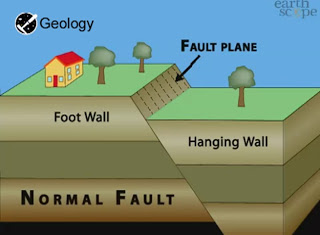Normal Fault
A type of fault in which the hanging wall moves down relative to the footwall, and the fault surface dips steeply, commonly from 50o to 90o. Groups of normal faults can produce horst and graben topography, or a series of relatively high- and low-standing fault blocks, as seen in areas where the crust is rifting or being pulled apart by plate tectonic activity. A growth fault is a type of normal fault that forms during sedimentation and typically has thicker strata on the downthrown hanging wall than the footwall.
Video :
Photos :
Normal fault. This outcrop of the eolian Entrada formation of Colorado (USA) contains numerous normal faults.Photo courtesy of T.N. Diggs.
Conjugate normal faults, Black Mountains frontal fault zone, Death Valley,California. | Photo credit: Martin Miller












